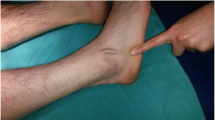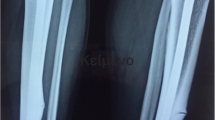Abstract
Introduction
To the best of our knowledge there is no other report of an elderly patient who was surgically treated for a patellar fracture with tension band wiring and who subsequently suffered from an avulsion fracture of the tibial tuberosity. The combination of a patellar fracture and avulsion of the patellar ligament has only been described as complication after bone-patellar tendon-bone anterior cruciate ligament reconstructions. However, due to demographic changes and more elderly patients treated this injury may become more frequent in future.
Case presentation
We present the case of an 81 year old female who sustained an oblique patellar fracture after a direct contact injury of the left knee when falling on ice. Consequently the patellar fracture was openly reduced and stabilized with tension band wiring. The follow-up was uneventful till three months after surgery when the patient noticed a spontaneous avulsion fracture of the tibial tuberosity (Ogden type 3). The tibial tuberosity fragment was reattached with two non-resorbable sutures looped around two modified AO cortical 3.5 mm long neck screws. Intraoperatively multiple bone cysts were seen. Biopsies were not taken to prevent further fragmentation of the tibial tuberosity. The patient was followed up with anteroposterior and lateral full weight bearing radiographs and clinical assessment at 6, 12 weeks and 6 months after surgery. Recovery was completely pain free with full satisfaction.
Conclusion
In conclusion in elderly patients with a patella fracture a possible associated but not obvious fracture of the tibial tuberosity should be ruled out and the postoperative rehabilitation protocol after tension band wiring of the patella might have to be individually adjusted to bone quality and course of the fracture.
Similar content being viewed by others
Introduction
To the best of our knowledge there is no other report of an elderly patient who was surgically treated for a patellar fracture with tension band wiring and who subsequently suffered from an avulsion fracture of the tibial tuberosity. The combination of a patellar fracture and avulsion of the patellar ligament has only been described as complication after bone-patellar tendon-bone anterior cruciate ligament reconstructions. However, due to demographic changes and more elderly patients treated this injury may become more frequent in future.
Case presentation
A 81 year old female had sustained a direct contact injury of the left knee due to a fall on ice. Radiologically a displaced oblique patellar fracture was proven in anteroposterior and lateral radiographs of the knee (fig. 1). No other injuries and/or fractures could be noted. At this time the patient was surgically treated with open reduction and tension band wiring of the patellar fracture (fig 2). Immediately after surgery full protected weight bearing was allowed for 6 weeks with an extension splint (SAMA, Salzmann Medico, St. Gallen, Switzerland). Anti-thrombotic prophylaxis was performed with low molecular weight heparin. Early functional physical therapy was initiated, for six weeks with limited passive flexion to 80°. Follow-up six weeks after surgery was done with clinical assessment and anteroposterior and lateral full weight bearing radiographs. At this time the activity related level of pain was rated as none. The patient was completely satisfied and passive range of motion for flexion/extension was 110°-0°-0°. Full weight bearing with unlimited range of motion was allowed after six weeks. Three and a half months after primary injury the patient felt a giving-way of the left knee when descending a stair during physiotherapeutic exercise. She heard a cracking sound and noted a stabbing pain in her lower leg. In anteroposterior and lateral radiographs an avulsion fracture of the tibial tuberosity (Ogden type 3a1) was observed (fig. 3). Retrospectively a multi-lobulated small cystic lesion at the tibial tuberosity was already present at the initial presentation. After a lateral parapatellar skin incision and medial parapatellar arthrotomy the tibial tuberosity fragment was refixed with two non-resorbable sutures (FibreWire®, Arthrex Swiss AG, Volketswil, Switzerland) which were looped around two modified 3.5 mm AO cortical long neck screws (fig. 4, 5). Intraoperatively multiple bone cysts were seen. Biopsies were not taken to prevent further fragmentation of the tibial tuberosity. Immediately after surgery protected full weight-bearing with crutches and an extension splint (SAMA, Salzmann Medico, St. Gallen, Switzerland) was allowed for two weeks. Anti-thrombotic prophylaxis with low molecular weight heparin was initiated. Passive flexion was initially limited to 35° for two weeks, then increased for the next two weeks to 70° and for the next two more weeks to full flexion under physiotherapeutic supervision.
The patient had a radiographic follow-up six weeks postoperatively with anteroposterior and lateral full weight bearing radiographs. Clinical assessment was done at 6, 12 weeks and 6 months after surgery. The patient was completely satisfied and pain free at the last follow-up. Range of motion was flexion/extension 125°-0°-0°. Radiographically the avulsion fracture had healed and there was no displacement of the tibial tuberosity (fig. 6).
Discussion
Avulsion fractures of the tibial tuberosity are uncommon injuries [1–6]. In adolescents this type of fracture accounts for less than 3% of all epiphyseal plate injuries [6, 7]. To our knowledge it has not been reported in the elderly. This case report is unique because it describes a case of a patient who was surgically treated for a patellar fracture with tension band wiring and who subsequently suffered from an avulsion fracture of the tibial tuberosity. The combination of a patellar fracture and avulsion of the patellar ligament has only been described as complication after bone-patellar tendon-bone anterior cruciate ligament reconstructions [8–10].
The aetiology of the tibial avulsion fracture in our case however remains unclear. It can only be speculated whether the fracture of the tibial tuberosity may be attributed to an overlooked injury of the tibial insertion of the patellar ligament at the time of the patellar fracture or whether the avulsion fracture may be a secondary stress fracture due to mechanical overloading. Even retrospectively there was no evidence of an avulsion to the tibial tuberosity, but a cystic lesion was apparent. Thus a secondary stress fracture seems to be a more reasonable cause of the injury. There were no other well known predisposing factors such as a patella infera, tight hamstrings, or a pre-existing Osgood-Schlatter's disease [7, 11].
It might be the case that the course of the patellar fracture itself and the subsequent need for an oblique placement of the k-wires played a role in the development of the avulsion fracture of the tibial tuberosity. The distal k-wire may have altered the tension within the patellar ligament. The question however remains what was the cause of the cystic lesion at the tibial tuberosity. Most likely it was due to osteoporosis related decreased mechanical resistance of the tibial tuberosity [12].
One could argue that the early functional rehabilitation program have led to the avulsion injury and should have been modified with regards to the age-related inferior bone quality at the tibial tuberosity. The rehabilitation program was modified after the second surgery.
The goals of treatment of acute tibial tuberosity avulsion fractures are anatomic reduction of the fracture fragment, restoration of extensor mechanism alignment, and maintenance of congruency of the tibial articular surface. Non-operative treatment (closed reduction and cylinder cast immobilization) is only indicated in undisplaced Ogden type 1 and 2 fractures, which do mostly occur in children and adolescents [6, 7]. In displaced avulsion fractures surgical treatment is indicated [1–7]. A variety of surgical methods such as transfixing pins or screws [6], staples [7], bone pegs [7], tension bands [6] or even direct suture [6] have been described for treatment of avulsion fractures of the tibial tuberosity. In our case a transfixation technique with a tension band wiring to neutralize the tension forces was performed. It led to a good functional result with a pain free patient at the last follow up control. No augmentation of bone, whether allo- or autograft, was necessary, but should be deliberately considered.
Conclusion
In conclusion in elderly patients with a patella fracture an associated, not obvious fracture of the tibial tuberosity, should be ruled out. Postoperative rehabilitation protocol after tension band wiring should be individually adjusted to bone quality and course of the fracture.
Consent
Written informed consent was obtained from the patient for publication of this case report and accompanying images. A copy of the written consent is available for review by the Editor-in-Chief of this journal.
References
Ogden JA, Tross RB, Murphy MJ: Fractures of the tibial tuberosity in adolescents. J Bone Joint Surg. 1980, 62: 205-215.
Uppal R, Lyne ED: Tibial tubercle fracture with avulsion of the patellar ligament: a case report. Am J Orthop. 2007, 36: 273-274. 10.1007/s00132-007-1047-x.
Vainionpaa S, Bostman O, Patiala H, Rokkanen P: Fracture of the tibial tuberosity in adolescents. Arch Orthop Trauma Surg. 1985, 104: 20-22. 10.1007/BF00449951.
Vella D, Peretti G, Fra F: One case of fracture of the tibial tuberosity in the adult. Chir Organi Mov. 1992, 77: 299-301.
Nimityongskul P, Montague WL, Anderson LD: Avulsion fracture of the tibial tuberosity in late adolescence. J Trauma. 1988, 28: 505-509. 10.1097/00005373-198804000-00015.
Mosier SM, Stanitski CL, Levine RS: Simultaneous bilateral tibial tubercle avulsion fracture. Orthopedics. 2000, 23: 1106-1108.
Nikiforidis PA, Babis GC, Triantafillopoulos IK, Themistocleous GS, Nikolopoulos K: Avulsion fractures of the tibial tuberosity in adolescent athletes treated by internal fixation and tension band wiring. Knee Surg Sports Traumatol Arthrosc. 2004, 12: 271-276. 10.1007/s00167-003-0417-0.
Frankl U, Wasilewski SA, Healy WL: Avulsion fracture of the tibial tubercle with avulsion of the patellar ligament. Report of two cases. J Bone Joint Surg. 1990, 72: 1411-1413.
Miller MD, Nichols T, Butler CA: Patella fracture and proximal patellar tendon rupture following arthroscopic anterior cruciate ligament reconstruction. Arthroscopy. 1999, 15: 640-643. 10.1053/ar.1999.v15.015064.
Bonatus TJ, Alexander AH: Patellar fracture and avulsion of the patellar ligament complicating arthroscopic anterior cruciate ligament reconstruction. Orthop Rev. 1991, 20: 770-774.
Baltaci G, Ozer H, Tunay VB: Rehabilitation of avulsion fracture of the tibial tuberosity following Osgood-Schlatter disease. Knee Surg Sports Traumatol Arthrosc. 2004, 12: 115-118. 10.1007/s00167-003-0383-6.
Wunsche F, Krzok G, Hauch S: Spontaneous and simultaneous rupture of the right patellar ligament and avulsion fracture of the left tibial tuberosity in osteomalacia. Beitr Orthop Traumatol. 1989, 36: 434-438.
Author information
Authors and Affiliations
Corresponding author
Additional information
Competing interests
The authors declare that they have no competing interests.
Authors' contributions
MTH reviewed the case and drafted the manuscript. BW participated in drafting the manuscript and case review. CM participated in drafting the manuscript and literature review. GI participated in drafting the manuscript and case review.
NFF participated in drafting the manuscript and case review. All authors read and approved the final manuscript.
Authors’ original submitted files for images
Below are the links to the authors’ original submitted files for images.
Rights and permissions
This article is published under license to BioMed Central Ltd. This is an Open Access article distributed under the terms of the Creative Commons Attribution License (http://creativecommons.org/licenses/by/2.0), which permits unrestricted use, distribution, and reproduction in any medium, provided the original work is properly cited.
About this article
Cite this article
Hirschmann, M.T., Wind, B., Mauch, C. et al. Stress avulsion of the tibial tuberosity after tension band wiring of a patellar fracture: a case report. Cases Journal 2, 9357 (2009). https://doi.org/10.1186/1757-1626-2-9357
Received:
Accepted:
Published:
DOI: https://doi.org/10.1186/1757-1626-2-9357










